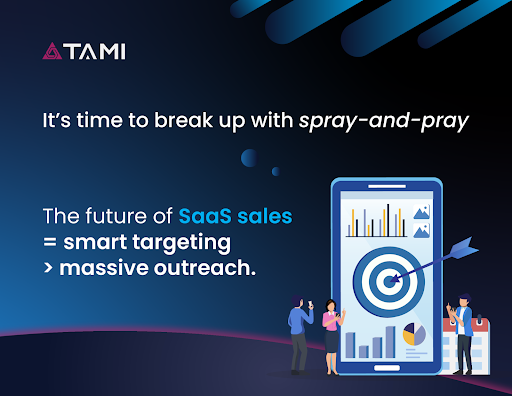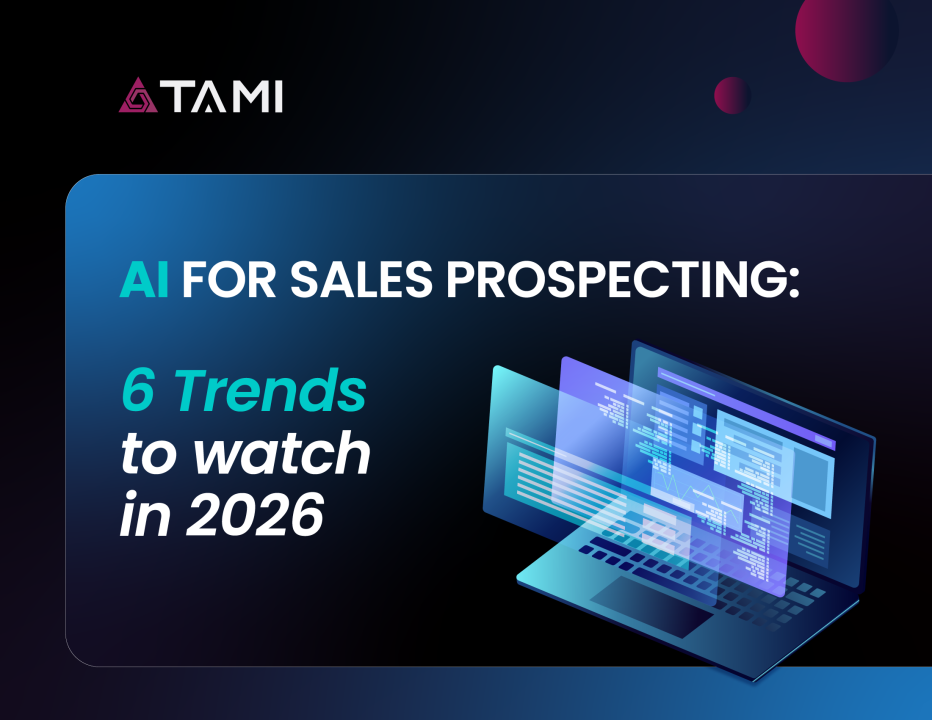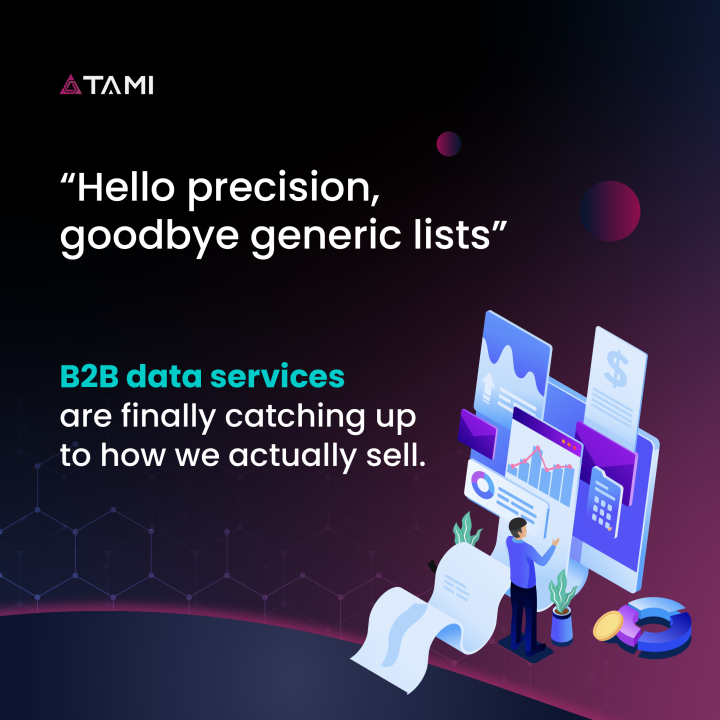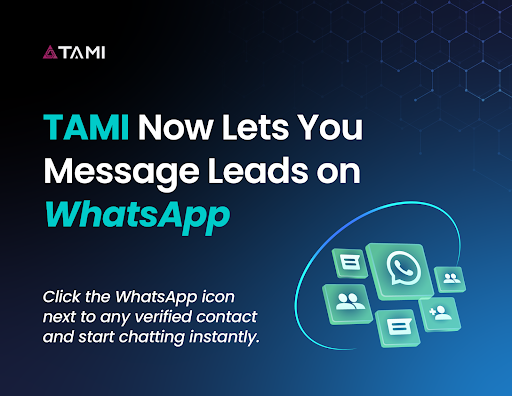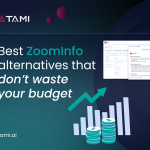
Best Zoominfo Alternatives that Don’t Waste Your Budget
15/10/2025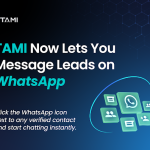
New Feature: Send WhatsApp Messages Directly from TAMI
05/11/2025In 2026, the SaaS sales landscape is going to reward precision over scale. The days when blasting broad contact lists and praying for replies are behind us. Instead, the winners will be the teams that target smarter, use real-time data, and build outbound strategies tuned to buyer intent.
The shift is already underway, and teams that lag will burn cash chasing unqualified leads.
In this article, we’ll walk you through the key trends that will reshape SaaS sales, show you how to structure a targeting-first outbound strategy, and explain how TAMI’s real-time data capabilities support this shift. You’ll walk away with tactical ideas, warning signs, and what to experiment with in 2026.
Why volume-first is dead (or dying)
First, the economic pressure demands higher efficiency. According to the 2024 benchmark report from Pavilion, many SaaS companies saw their blended CAC ratio climb, and sales/marketing expenses to acquire revenue increased year over year.
Second, buyer behavior has matured. Prospects now expect personalization, relevance, and signals of understanding. Generic outreach is ignored or flagged as spam. In outbound for B2B SaaS, the trend is toward precision, personalization, and smart automation. In 2025, outbound isn’t dead, but it has evolved. The same applies in 2026.
Third, technology enables targeting that outperforms volume. With machine learning, intent data, predictive analytics, and real-time enrichment, you can filter out low-probability leads before spending a dollar. Sales and revenue teams that refuse to adopt these tools will be left behind.
So in 2026, quantity counts far less than quality. The question becomes: how do you practically build a targeting engine that outcompetes those still chasing email lists?
Building a targeting-first SaaS sales strategy for 2026
Here’s what a truly targeting-first approach looks like and how SaaS sales teams can start building one that’s efficient, data-driven, and built to scale in 2026.
1. Refine your ICP to be data-powered and dynamic
In volume models, ICPs are broad. In targeting-first models, ICPs must be precise and responsive to data. Start by layering technographic, behavioral, and competitive signals onto firmographic criteria.
For example: SaaS firms using X analytics suite, with Y number of users, who recently raised funds, and are switching from a competitor. Use TAMI’s AI intelligence to spot those combinations in real time.
Your ICP should evolve continuously. If a segment shows strong conversion rates, lean into it. Drop segments where the pipeline never materializes. Don’t treat ICP as static when it should be a live hypothesis.
2. Use multi-dimensional signal scoring, not just demographics
Targeting in 2026 must go beyond job titles and company size. You should score leads using intent signals (e.g., downloading content, visiting product pages), technographic shifts (switching software stacks), competitor engagement (prospects using your rivals), and engagement signals (email opens, web visits).
Each signal should add or subtract from a lead’s score. This is how you find the 5 percent worth spending effort on.
TAMI’s continuous enrichment helps here by tracking many data layers (payment providers, shipping partners, tech stacks) so you can identify when prospects cross relevant thresholds. That visibility is what allows outbound teams to be opportunistic rather than blind.
3. Align messaging with real-time insight
When your targeting is sharper, your messaging must follow. Every touchpoint should reference something recent or specific: a technology change, a competitor they use, a pain they likely feel. The transition is from generic pitch to context-led insight.
The more you bring evidence that you "get" the business and its challenges, the higher reply rates you’ll see. Outreach that reflects real-time intelligence wins attention.
4. Test with small cohorts, iterate fast
Don’t build a massive campaign before validating your approach.
Launch test sequences to small, high-scoring cohorts. Measure which signals convert, which messages get replies, and where the drag is. Use those learnings to refine your targeting rules and messaging before scaling.
In modern outbound, campaigns are experiments. You should know by week two whether your hypothesis is working or needs adjustment.

5. Build feedback loops to learn continuously
Your targeting engine must receive real feedback. That means logging replies, meetings, conversion data, and tying them back to the signals you used.
Over time, you train your model: which signals predict buying, which don’t. That feedback lets you sharpen ICPs, remove noise, and increase yield.
If your data stack is disconnected, you’ll lose these loops. Real-time sync and enrichment are essential to keep your model current and accurate.
What this looks like in practice (with TAMI in the loop)
Imagine your outbound team receives a daily list of 50 accounts flagged by TAMI as having newly switched to a key technology your product competes with. Those accounts match your refined ICP. Because TAMI continuously refreshes tech-stack data, you know these are fresh, not stale leads.
You then score them further with intent signals (e.g., they viewed a blog post on migration). You send personalized outreach referencing the change, mention a case study, or bring up a challenge common to that shift. A handful reply, you test variations, you adjust.
Over time, your pipeline efficiency improves. You generate 25–50 qualified meetings from 50 accounts, rather than sending to 500 accounts and hoping for a few replies. Your CAC drops, sales velocity rises, and your team is rewarded for intelligence, not volume.
The key difference is that your outbound becomes selective. You spend effort where there’s a signal, not spread thin trying to hit many.
Risks, pitfalls, and what to avoid
If your targeting is too narrow, you’ll starve the pipeline. You need balance: broad enough to feed discovery, narrow enough to filter waste. The initial experiments will reveal that balance.
Relying on single signals (e.g., only job title) is dangerous. Those are easy to game or misinterpret. Always combine multiple dimensions.
If your tech and data stack can’t sync in real-time, your targeting degrades. Static CSVs, manual imports, or slow refreshes kill what you’re trying to build. That’s why real-time enrichment matters.
Finally, don’t ignore messaging and execution. Even the best targeting fails with weak outreach. You need sequence testing, copy evolution, channel mixing, and feedback-driven refinement.
What to prioritize in 2026
As SaaS markets mature and competition tightens, sales teams in 2026 will need to focus their resources on the areas that directly influence pipeline quality and conversion efficiency. The priorities below reflect where top-performing teams are already investing their attention.
- Build or enhance your data stack so that signals (tech change, intent, competitor usage) feed directly into targeting logic
- Focus your outbound campaigns on top-quartile segments rather than chasing total volume
- Tighten alignment between product, marketing, and sales so messaging reflects real product differentiation
- Constantly review your scoring, signal weights, and feedback loops to prevent drift
- Use tooling that supports continuous updating, not manual cleanses
When you shift to targeting-first SaaS sales, you’ll find your pipeline becomes more predictable, your sales time more efficient, and your budget more defensible.
Final thoughts
The companies growing fastest in 2026 will be those that align data, targeting, and timing to reach prospects when intent is high. Success now depends on accuracy, clean data, and meaningful engagement, not on sending more emails.
TAMI helps SaaS teams make that shift. With real-time enrichment, verified contacts, and insights into competitors, technologies, and intent signals, it turns outbound into a predictable, data-driven process that delivers qualified leads instead of inflated lists.
If your sales team is ready to compete in a targeting-first era, start using data that actually converts. See how TAMI can help your team reach the right buyers faster. Book a free demo today and experience smarter, more efficient SaaS sales in 2026.

